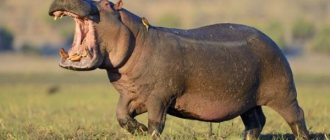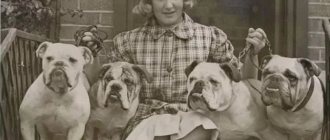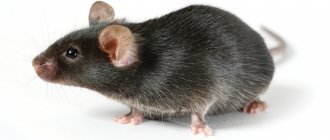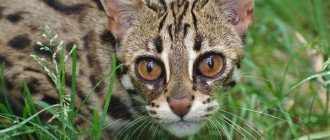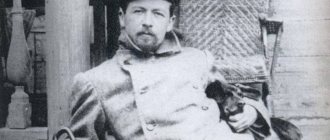The process of reproduction is one of the basic instincts of animals. The penis is a kind of instrument for introducing seed into the female genital tract and for conceiving offspring. Also, in some cases, the penis serves to remove urine from the body. The size of the reproductive organ in different representatives of the animal world can vary significantly. In this article, we will look at the length of animal penises and find out whether there is a pattern in the growth and length of the reproductive organ. Let's get acquainted with interesting facts about animal reproduction.
Dimensions
The average size of the male genital organ in its normal state is approximately 9.2 cm, and in an erect state it is 13.1. The erect penis in the studies was measured from the pubic bone. The measurement of the resting penis was carried out from its base.
Who you are?
Man.
76.69%
Woman.
23.31%
Voted: 6481
Super small
Another name for such a member is micropenis. Its length when stretched is no more than 8 cm. Micropenis is associated with hormonal disorders in which insufficient testosterone is produced. This hormone affects the normal development of the genital organs.
Small
The size of this penis in a tense state is 8-13 cm.
Average
The average size is 13-15 cm. It is found in most representatives of the stronger sex.
Big
Large penises are those that are between 15 and 20 cm when erect.
Huge
The length of such phalluses is more than 20 cm. A certain Jonah Falcon had a recorded penis size of over 34 cm. This is a record for today.
Thick
A penis is considered thick if it is more than 5 cm thick.
Thin
Thin phallus - having a thickness of less than 3 cm.
John Falcon - the owner of the greatest “dignity”_8212__171187
Interestingly, the largest penis was recorded in a man named John Falcon. The size of its dignity reaches 34.5 centimeters. It is noteworthy that large size is most likely transmitted at the genetic level from father to son.
Many people joke about the number of people in China, but in fact this fact can be explained by the presence of long penises among Chinese men. This guarantees almost one hundred percent conception, because the sperm is shot very close to the uterus and fertilization occurs in almost all cases. However, the largest penis in length after the clear leader Falcone was recorded not in a Chinese man, but in a resident of the Congo – more than 17 centimeters.
Teen sizes
The average length of a stretched penis at birth is about 4 cm. Until the age of five, the organ grows slightly, and then it increases slightly. The next leap occurs during puberty.
At 10, 11, 12 years old
Normal penis size indicators for teenagers:
- at 10 years old - 3-5 cm at rest and approximately 7-9 cm during erection;
- at 11 years old - 3.5-5.5 and 7.5-9.5 cm;
- at 12 years old - 4-6 and approximately 11 cm.
At 13, 14, 15 years old
From the age of 13, the penis increases noticeably:
- at 13 years old - 5-7 cm in a non-excited state and approximately 12-13 cm during excitement;
- at 14 years old - 6-8 and 14-15 cm;
- at 15 years old - 6 - 8 and 15.5 cm;
At 16, 17, 18 years old
At this time, the growth of the penis ends. Its dimensions:
- at 16 years old - 6.5-9.5 cm at rest and 16.5 with erection;
- at 17 years old - 7.5-10.5 and 17 cm;
- at 18 years old - 8.5-11.5 and 16.5 cm.
What determines the size of the penis?
The shape and size of the penis depend on genetics and a number of other factors.
Age
The penis grows in length up to 17-18 years. With age, some reduction in the organ is possible due to a decrease in hormonal levels.
Hormonal background
Puberty begins at approximately 12 years of age and ends at 17–18 years of age. At this age, the production of hormones that are responsible for the development of the cavernous bodies increases. With hormonal imbalance, penis growth may slow down.
Nutritional Features
The lack of proteins, fats and carbohydrates during puberty negatively affects the parameters of the phallus.
Ecological situation
Changes in the parameters of the penis can be adversely affected by pesticides and synthetic antimicrobial agents. They negatively affect the hormonal system of men.
Excess weight and associated diseases
Sexually transmitted diseases and exposure to pathogenic bacteria lead to destruction and deformation of penile tissue.
Features of hippopotamus nutrition
Hippos are herbivores. Their food consists of semi-aquatic and terrestrial grasses. Interestingly, they do not eat aquatic vegetation. Hippos graze on land and literally “cut” the grass to the roots. An adult eats from 40 to 70 kg of food per day.
During grazing, hippopotamuses stay separate from other individuals, although in general they are herd animals. Only females and cubs always feed together. Hippos do not go further than 3 km from the water in search of food.
Recently, information has also appeared about the predatory behavior of hippopotamuses, attacks on gazelles, antelopes, and cows.
Penis shapes
There are different forms of penises. They are individual and different for each man. The shape of penises depends on a large number of factors. The main one is heredity. There is no complete idea of the “ideal” shape of a penis.
Straight
This genital organ has no bends - neither horizontal nor vertical. When erect, he “looks” straight. In some men, the straight penis has an arrow-shaped appearance.
Mushroom
In this case, the man can boast of a thin trunk and a wide head. It resembles a mushroom cap. The head can be different: from narrow at the tip to round.
Conical
Such members are also quite common. They have a fairly long, thick trunk with a smaller head. The general appearance of the penis resembles a cone - wider at the base and narrower at the top.
Cylindrical
This is one of the most common forms of the sexual organ. It is smooth, without any curvature. Sometimes veins on the penis may appear slightly. All parts of the penis have approximately the same thickness.
Barrel-shaped
Despite the modest length of such a penis, its diameter reaches impressive sizes. In a non-excited state, this feature of the penis is invisible. However, when erect, the organ is thick and resembles a barrel.
Curved
This type of penis has a tilted head and a shaft in any plane. Sometimes oblique curvature occurs.
Unusual shape
There are various unusual members.
Banana
This penis is banana shaped. When erect, it has a pronounced bend, “looking” down. The functionality of the organ does not suffer from this.
9 options for the 69 position in sex, its pros and cons
Graviola
This phallus is similar to graviola, an African plant. Then in the erect state it is short and very wide.
C-like
When erect, the penis bends to the right. The anomaly often occurs in men who have previously injured the genital organ.
Population and species status
In some areas, black rhinoceroses are on the verge of extinction. The total number of these mammals is at the level of 3 and a half thousand individuals. It should be noted that black rhinoceroses in countries such as Namibia, Mozambique, Zimbabwe and South Africa have maintained their numbers at such a level that hunting them is allowed. In these countries, the shooting of such animals is regulated by law. The shooting of white rhinoceroses is carried out according to special quotas, which are controlled quite strictly.
Indian rhinoceroses are listed in the International Red Book and have the status of a vulnerable species. The total number of the species is estimated at 2 and a half thousand individuals. Despite this fact, Indian rhinoceroses are considered a fairly prosperous species, compared to some species.
Javan rhinoceroses are extremely rare animals in our time, since their total number is at the level of 6 dozen individuals. As for the Sumatran rhinoceroses, their numbers are endangered due to the fact that the life activity of the species is poorly understood. This fact does not allow creating more comfortable living conditions in captivity, closer to natural ones.
Penis differences
It is quite difficult to answer what differences there are in members. After all, there is no definite norm visible here. Doctors have identified the following types of genital organs:
- Thick. These have a fairly large volume, but the length can be medium or short. Sometimes it can visually resemble a barrel. It happens that the penis is impressive both in length and width.
- Thin. The thickness of the penis is quite modest. The length varies. Such phalluses are characterized by an arrow-shaped shape.
- Long. Usually the length of the phallus is more than 15 cm. There are cases when, despite the large length, the thickness is insignificant.
- Short. This phallus is less than 12 cm. Its thickness varies widely.
Wiry
Owners of such members can boast of a pronounced feature, namely noticeable veins. Sometimes such members look impressive due to their large size.
Fleshy
A meaty penis is usually large, even when not erect. Sometimes thick varieties are found.
By erect position (hook, pike, root)
There are the following types of penises by position:
- “root” (directed downward during erection);
- “root hook” (directs upward from the base and then curves horizontally);
- “hooked pike” (protrudes horizontally from the base and then curves upward);
- “rooted pike (from the base it goes horizontally and then curves in the lower direction);
- hammer (this penis has an enlarged head);
- arrow (head narrowed).
According to the shape of the curvature
A curved penis is characterized by varying degrees of deviation of the head or body in any direction. Often the penis is curved in different directions.
The curvature of the phallus is not always due to physiological factors. Severe curvature of the penis occurs as a result of Peyronie's syndrome. With this disease, there is a curvature of the penis towards the abdomen. Men feel pain in the penis when it is tense.
By size of foreskin
The length of the foreskin varies widely. The members are distinguished:
- without foreskin (men underwent circumcision surgery);
- uncircumcised with a short prepuce;
- uncircumcised with a normal-sized prepuce;
- with a long prepuce (in this case, the norm is fixed only when the head opens normally and no pathological phenomena are observed).
When characterizing the size of the prepuce, it is necessary to pay attention to the fact that some men may have phimosis. Phimosis means the inability to expose the head to any degree.
By presence of hair
There may be hair on the body of the phallus, and this is normal. It's also okay if there aren't any.
Hippo behavior
Hippos live near the shores of fresh water bodies. These can be large rivers or lakes, or small mud lakes. The main requirements for it are that it can accommodate the entire herd and not dry out all year. In addition, it is important for the animal to have a grassy lowland for grazing next to a pond. If conditions worsen, hippos are capable of migrating to another body of water, but long-distance overland travel is still not typical for them.
The life of a hippopotamus has a clear daily rhythm. During the day, the animals are in the water, where they sleep with their heads out, and graze at night.
Adult males, who do not have their own harem, live alone and often fight for territory. Such fights are long and brutal; animals are capable of causing serious injury to each other, even death. Hippos behave especially aggressively on the shore. They do not like their neighbors and drive away all strangers, including even rhinoceroses and elephants. The length of an adult male's range is 50-100 meters on the river and 250-500 meters on the lake.
When an animal leaves the water and goes to feed, it uses the same individual path. In soft soil, such trails become wide and deep ditches, prominent features of the landscape. The animal moves on land in steps. Maximum speed up to 30 km/h.
In addition to single males, hippos form herds of 20-30 individuals, and young, immature males stay in bachelor groups.
Hippos have a very developed vocal communication system; with the help of various signals they are able to express danger, aggression and other feelings. The sounds are usually roaring or grunting. The loud voice of a hippopotamus, up to 110 decibels, carries very far across the water. The hippopotamus is the only mammal capable of making sounds both on land and in water.
These animals also very actively spray their excrement and urine, which serves to mark territory and for communication.
How to increase
Men often want to increase the length and girth of their penis. This should be done when the organ size is up to 9.5 cm in an erect state. There are the following ways to do this:
- exercises and massages aimed at stretching the phallus;
- extenders that lengthen and thicken the organ;
- surgical operations;
- nozzles;
- vacuum pumps;
- injections;
- creams, sprays and gels;
- Dietary supplements, herbs, vitamin preparations.
300 phrases during sex: what words to say to excite your partner
Ways of affection
Here are the methods used to caress the penis:
- stimulate the trunk by lightly patting it with the phalanges of your fingers;
- clasping the penis, make back-and-forth movements with your fingers;
- run two palms over the penis;
- Having formed a ring with your thumb and forefinger, grab the penis and move your hands;
- clasping the penis at the base with one hand and the head with the other, perform circular movements;
- caress the penis in the shower;
- massaging the penis, caressing the testicles;
- using lubricant, run your hand along the inner thigh, approaching the scrotum and penis;
- caress the penis with your tongue;
- use a vibrating erection ring;
- use rose petals, feathers, hair for touching.
Answers to frequently asked questions
Which one do girls like?
It is difficult to answer this question unequivocally. The preferences of each girl are individual, as are the size and shape of the penis.
Can size be determined by other parts of the body?
There are no ways to determine penis size without a ruler. It is impossible to determine the dimensions of the phallus by the thumb, foot size, nose length, etc. There is no scientific explanation for this.
Is size inherited?
DNA contains all the characteristics of an organism, including penis size. However, in addition to genetics, it is influenced by nutrition and hormonal levels.
To what age does it grow?
The penis usually grows until the age of 17. Until the age of 25, there is a slight increase in the thickness of the penis.
Can women have penises?
Women cannot have male genitalia. The sex of a person is determined by external signs.
What is the taste and smell?
The taste of a penis, according to girls, is different. It comes in: salty; resembling a banana wrapped in ham; reminiscent of blue cheese; clean, diluted with notes of musk; tender and sweet; meat; salty-sweet; sour; bitter. A clean penis has a pleasant smell. It feels different to every girl.
Can it be broken?
A fracture of the penis occurs when excessive physical force is applied to it during an erection. At the moment of fracture, a characteristic cracking sound is heard. The most common cause of a fracture is careless movements of both partners during sexual intercourse. A fracture can also occur as a result of a knife or gunshot wound. Signs of a fracture: acute pain, sudden cessation of erection, crunching, swelling, hematoma, curvature. Such a serious injury requires immediate surgical intervention.
Anatomy
To understand the functioning of an organ, it is important to know its anatomy.
What does BDSM mean in sex and how to practice it correctly
Structure
The penis has the shape of a cylinder and consists of a front (movable) and an internal (fixed) part. The front part has a body ending in a thickened part - the head. The urethra (urethra) opens at the apex. The widest part of the head of the penis is called the crown.
The penis has thin and flexible skin on top. There is a seam on the underside of the penis. From behind it passes to the scrotum and perineum.
At the end of the penis is the foreskin (prepuce). The prepuce covers the head and exposes it with slight movement. On the back side the head passes into the frenulum. The inner tissue of the prepuce and head are covered with very thin skin. Between them there is a preputial cavity. On the inner layer of the foreskin, glands that produce lubricant open. In some men, due to the narrowed opening of the prepuce, the head is almost or completely not exposed. This pathology is called phimosis and requires therapy. In boys under three years of age, phimosis is physiological and does not need correction.
The head and frenulum are rich in nerve endings. When they are stimulated, pleasant sensations arise and an erection appears.
The basis of the reproductive organ is two cavernous (cavernous) bodies and a spongy body. Cavernous bodies are cylindrical in shape. They begin from the periosteum of the pubic and ischial bones. The cavernous body is covered with a tunica albuginea. From it emanate processes - connective tissue trabeculae. The connective tissue contained in them, during contraction, retains blood during erection. Inside the corpus cavernosum there are cavities called “caves”. During an erection, their volume increases significantly.
The corpus spongiosum is much smaller in size than the cavernous one. Its front part goes into the head.
Blood flows to the penis through deep arteries - branches of the genital artery. Venous blood flows through deep veins. The penis is innervated by the dorsal nerve (a branch of the pudendal nerve). Sympathetic nerves depart from the hypogastric plexuses, located below, and parasympathetic nerves from the pelvic internal plexuses.
Color
The penis is usually darker than the rest of the skin. The darker shade is found in all adult men, regardless of race.
When a teenager begins puberty, his body produces more male sex hormones - androgens. They are responsible for secondary sexual characteristics. These include skin pigmentation.
Hormones interact with skin cells that produce melanin. Because of this, the penis, scrotum and groin area are slightly darker than the rest of the body.
The best vibrator for women: 64 models for various purposes
Unnatural darkening of the penis is a consequence of such pathologies:
- hormonal imbalance,
- diabetes mellitus,
- obesity,
- acanthosis nigricans.
There are many men whose penis is red or brownish in color. This color is a variant of the norm. It is also normal if there are dark spots on the skin of the phallus. When excited, it may appear darker or redder. All color variations during erection are normal.
Sometimes the skin of the phallus is lighter than the color of the rest of the skin. The shade of the genital organ can be inconsistent: in an erect state the organ is one shade, and in its normal state - another. This phenomenon is physiological if it is not a symptom of a disease.
Texture
Most male penises are not completely smooth. Their veins are usually visible and protrude slightly, especially during arousal. It is normal to have small growths on the skin. They usually appear after puberty ends. Half of men have small, light, painless bumps on their scrotum.
Evolution of male reproductive organs
Syngamy (sexual reproduction) is the result of centuries of evolution. In the process of phylogenesis, the first of all elements of the reproductive system to appear are sex cells - gametes. Already in such primitive forms of life as sponges, eggs and sperm can be distinguished, but they do not yet have special genital organs.
The further development of the reproductive system was the formation of gonads - organs in which gametes develop. At this stage of evolution, the gonads do not have special pathways for the excretion of reproductive products, as a result of which a connection is formed between the reproductive and excretory systems, which can be traced throughout the entire phylogeny.
Further development of the reproductive system led to the appearance of tube-shaped organs through which mature reproductive products move. The connection between the urinary and reproductive systems is preserved. The reproductive tracts in males are the excretory ducts of the kidneys, the Wolffian ducts. Fish and amphibians have such a system, consisting of germ cells, gonads and reproductive tracts. Fertilization can be external or internal (in this case, copulation is carried out using the cloaca, since there are no special copulatory organs). Further complexity of the reproductive system is observed in reptiles and birds. Their testes are located in the body cavity, but the path of the sperm has been lengthened due to the appearance of the epididymis. In its tubules the accumulation and maturation of sperm occurs. For the first time in evolution, the males of some reptile species appear in the cloaca area with special, but still very primitive copulation organs that ensure internal fertilization.
In placental mammals, the reproductive system has become even more complex. The testes and their appendages in most mammals descend from the abdominal cavity and are located in a special testicular sac. The accessory sex glands, the true penis, and the prepuce develop.

